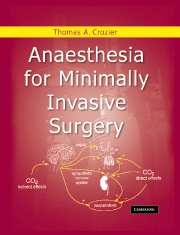Book contents
- Frontmatter
- Contents
- Preface
- Foreword
- Acknowledgements
- 1 Introduction
- 2 Physiology
- 3 Preparing and positioning for laparoscopic surgery
- 4 Monitoring
- 5 Anaesthesia for laparoscopic surgery
- 6 Complications and contraindications of laparoscopic surgery
- 7 Post-laparoscopy pain and pain relief
- 8 Laparoscopic bariatric surgery
- 9 Minimally invasive thoracic surgery
- 10 Laser surgery of the upper aerodigestive tract
- 11 Minimally invasive neurosurgery
- Index
11 - Minimally invasive neurosurgery
Published online by Cambridge University Press: 21 October 2009
- Frontmatter
- Contents
- Preface
- Foreword
- Acknowledgements
- 1 Introduction
- 2 Physiology
- 3 Preparing and positioning for laparoscopic surgery
- 4 Monitoring
- 5 Anaesthesia for laparoscopic surgery
- 6 Complications and contraindications of laparoscopic surgery
- 7 Post-laparoscopy pain and pain relief
- 8 Laparoscopic bariatric surgery
- 9 Minimally invasive thoracic surgery
- 10 Laser surgery of the upper aerodigestive tract
- 11 Minimally invasive neurosurgery
- Index
Summary
Minimally invasive neurosurgery has seen a resurgence in popularity in recent years. Some of this enthusiasm is a semantic phenomenon, since a wide variety of minimally invasive operations, both intracranial and spinal, have been routine for years, if not decades. In fact, there is substantial evidence that minimally invasive neurosurgery has been performed on an outpatient basis for many centuries (Figure 11.1). One of the most frequently performed minimally invasive neurosurgical operations was introduced into clinical practice over a century ago by the Swiss physician Gottlieb Burkhardt. First used to alleviate the severe symptoms of schizophrenia, it became popular in the 1930s after the Portuguese neuropsychiatrist, Antonio Egas Moniz (awarded the 1949 Nobel prize for his work) described his success in the treatment of patients with emotional disorders. In this procedure, a slender wire knife is inserted through small burr holes in the skull to sever the pathways connecting the frontal and prefrontal cortex to the thalamus. It gained notoriety through the efforts of Freeman and Watts, who performed the procedure indiscriminately on individuals with undesirable behaviour on an outpatient basis in their office. In its most ghastly form, known as the “ice-pick lobotomy”, an ice-pick was driven through the roof of the orbits with a mallet under local anaesthesia, and flicked back and forth to sever the fibres.
Neurosurgical endoscopy is a technique that was introduced in the early 20th century, when open brain surgery was associated with high mortality rates.
- Type
- Chapter
- Information
- Anaesthesia for Minimally Invasive Surgery , pp. 177 - 188Publisher: Cambridge University PressPrint publication year: 2004



